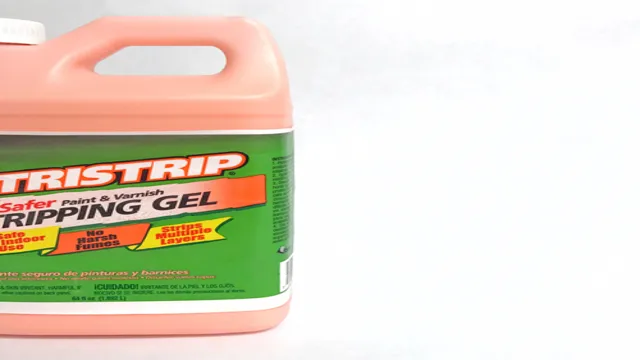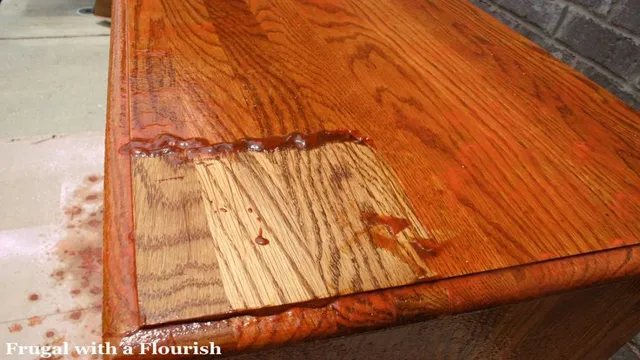Are you wondering if you can use Citristrip in cold weather? Well, the short answer is yes, but it’s not as simple as just slapping it on and waiting for it to work its magic. There are a few things you should know about using Citristrip in colder temperatures to ensure you get the best possible results. Whether you’re a seasoned pro or just starting out, this guide will give you all the tips and tricks you need to know to get the job done right.
So, let’s dive in and discover the dos and don’ts of using Citristrip in cold weather.
Understanding Citristrip and Its Properties
When it comes to using Citristrip in cold weather, there are a few things to keep in mind. First and foremost, this popular stripping agent is most effective at temperatures between 65 and 85 degrees Fahrenheit. If the temperature drops below 65, the Citristrip may not work as well, and it may take longer to achieve the desired results.
Additionally, if you’re working in a particularly cold environment, Citristrip may thicken and become more difficult to apply. In this case, you may want to consider warming the product up before use. Despite these challenges, many DIYers have found success using Citristrip in the winter months, as long as they are prepared to adapt their technique to the conditions at hand.
With a little patience and flexibility, it’s possible to achieve great results using this versatile stripping agent regardless of the temperature outside.
What Citristrip Is and What It’s Used For
Citristrip is a popular stripping product that is used to remove paint, varnish, and other finishes from surfaces. What sets Citristrip apart from other stripping products is that it is made from natural ingredients, specifically citrus fruit oils. This makes Citristrip not only biodegradable but also safer for the user and the environment.
In addition, Citristrip has a pleasant smell compared to other stripping products which can have harsh chemical odors. Its gel-like consistency allows it to cling to vertical surfaces while removing the finish without damaging the underlying surface. Citristrip is an effective and safer alternative for those who are looking to remove paint or varnish from their furniture or wooden surfaces.

How Citristrip Works
Citristrip is a powerful paint stripper that is easy to use and contains natural ingredients. This product is widely known in the market for its effectiveness in removing different types of paints and varnishes from surfaces like wood, metal, and masonry. The active ingredient in Citristrip is d-limonene, which is extracted from the rinds of citrus fruits.
This means that the product has a pleasant smell and is less harmful to people and the environment compared to other chemical strippers. The properties of Citristrip make it easy to apply and remove, and it can work on curves and detailed surfaces where sanding is not feasible. To apply Citristrip, you need to brush the product onto the desired surface, wait for a few hours for the paint to dissolve, and then scrape the paint away with a scraper or putty knife.
The result is a clean and smooth surface ready for finishing or repainting. In conclusion, understanding the properties of Citristrip is essential to make the most of its benefits in removing unwanted paint, and we recommend the use of this product as a safe and effective way to renovate surfaces.
Citristrip’s Ideal Temperature Range
Citristrip Citristrip is a well-known and highly regarded paint and varnish stripper that is widely used and appreciated by DIY enthusiasts and professionals alike. However, many people are not aware that Citristrip’s effectiveness is dependent on the temperature range at which it is used. The ideal temperature range for using Citristrip is between 65 and 85 degrees Fahrenheit.
If the temperature falls below or above this range, the product may not work as effectively as intended. So, it’s important to check the weather forecast before starting your project and plan accordingly. Using Citristrip at the right temperature range ensures the product works effectively and saves you both time and money.
Therefore, if you want to get the best possible results from your Citristrip, be sure to use it in the ideal temperature range and enjoy the benefits of its powerful properties.
Using Citristrip in Cold Weather
If you’re looking to strip paint or varnish from a surface in cold weather, you may be wondering if you can still use Citristrip. While the ideal temperature range for using Citristrip is between 65-85 degrees Fahrenheit, it can still be used in colder temperatures. However, it may take longer for the product to work and you’ll need to take a few extra precautions.
To help the product work more efficiently in colder weather, you’ll need to keep the surface warm. You can do this by raising the room temperature, using a space heater or heat gun, or by covering the surface with a plastic sheet to trap heat. Be sure to also apply a thick layer of Citristrip to the surface and let it sit for at least 30 minutes, or longer if needed.
It’s also important to wear protective gear and work in a well-ventilated area, as the product may release fumes. By taking these steps, you can still effectively use Citristrip in colder temperatures.
The Risks of Using Citristrip in Cold Weather
If you’re planning to use Citristrip to remove paint or varnish during winter, you may face some risks. Cold temperatures can impact the effectiveness and overall safety of this popular stripping agent, especially if you’re dealing with large, flat surfaces. When temperatures are too low, Citristrip can become thick and difficult to apply, leading to a less effective stripping process.
Additionally, using Citristrip in cold weather can increase the curing time, putting the surface at risk of developing cracks or peeling. If you’re set on using Citristrip during winter, it’s best to do it indoors and keep the room at a suitable temperature to ensure a proper stripping process. However, if possible, it’s best to wait for warmer weather to use Citristrip for your DIY projects.
Tips for Using Citristrip in Cold Weather
If you’re looking to use Citristrip in cold weather, there are a few things to keep in mind. First, be aware that colder temperatures can slow down the stripping process, so you may need to leave the Citristrip on for longer than usual. Additionally, it’s important to make sure the surface you’re stripping is at least 50°F, as Citristrip won’t work properly below that temperature.
You can use a space heater or other source of heat to warm up the area if necessary. Finally, be patient and don’t rush the process. Citristrip is a gentle and effective way to remove paint and varnish, but it may take a bit longer in cold weather.
With these tips in mind, you can successfully use Citristrip even in chilly temperatures.
Prepping Your Work Area in Cold Weather
When it comes to prepping your work area in cold weather, it’s crucial to take extra precautions to ensure a successful result. If you’re planning to use Citristrip, a popular paint and varnish remover, you need to be aware of the temperature outside. Citristrip is best applied between 65-85°F and if the temperature is too cold, it won’t work effectively.
If the weather is chilly, try warming up the area with portable heaters or wait for a milder day. Another important factor to consider is ventilation. When working with chemicals, it’s essential to have adequate fresh air flow to avoid inhaling any fumes.
Open windows and doors or invest in a high-quality fan to keep the air circulating. Ultimately, prepping your work area may require a bit more effort in cold weather, but by taking the necessary steps, you can ensure a successful and safe painting or refinishing experience that will withstand the test of time.
Conclusion and Final Thoughts
In conclusion, while Citristrip may be a powerful and effective paint stripper, it has its limitations when it comes to cold weather. Just like how we bundle up in warm layers to protect ourselves from the harsh winter chill, Citristrip also requires a certain level of warmth to work its magic. So, if you’re hoping to strip some paint in frigid temperatures, it might be best to wait until the mercury rises a bit.
As the saying goes, even the mightiest paint stripper needs a little heat to get the job done.”
FAQs
What is the ideal temperature range for using Citristrip?
Citristrip is best used in temperatures between 65°F and 85°F. Using it in colder temperatures may slow down the stripping process.
Can Citristrip freeze and become unusable in cold weather?
Yes, Citristrip may freeze and become unusable if exposed to extremely cold temperatures. It is important to store and handle the product according to the manufacturer’s instructions.
Will using a heat source such as a space heater help to use Citristrip in colder temperatures?
While using a heat source in colder temperatures may help speed up the stripping process, it can also be dangerous and cause fire hazards. It is best to follow the manufacturer’s instructions for use and storage.
Is there a specific humidity level requirement for using Citristrip?
Citristrip can be used in various humidity levels, but it is best to avoid using it in extremely humid conditions. High humidity may slow down the stripping process and affect the overall effectiveness of the product.
Can Citristrip be used indoors during cold weather?
Yes, Citristrip can be used indoors during colder temperatures as long as there is proper ventilation. It is important to open windows or use fans to ensure that the area is well-ventilated during use.
How long does Citristrip take to work in colder temperatures?
Citristrip may take longer to work in colder temperatures, but it typically takes between 30 minutes to 24 hours to remove paint or other coatings. It is important to follow the manufacturer’s instructions for application and removal.
Can Citristrip be safely used on all surfaces during cold weather?
Citristrip can be used on various surfaces, but it is important to test the product on a small, inconspicuous area before applying it to the entire surface. Some surfaces may be more sensitive to temperature changes and require specific handling instructions.






